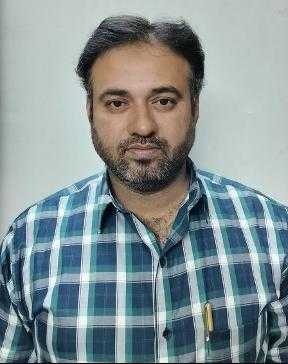
Expert Physiotherapy at Home
Certified physiotherapists visit you at home to provide focused, one-on-one care tailored to your needs. With no travel or waiting rooms, recovery happens in a setting that is comfortable, familiar, and built around your convenience.
Personalised Recovery Programmes
Every treatment plan is designed to suit your condition, goals, and pace. Our physiotherapists follow structured, evolving protocols to ensure consistent progress, with each session aligned to deliver meaningful results.
Trusted Physiotherapists. Real Results.
Our team comprises experienced, background-verified physiotherapists trusted by thousands of families. With a strong focus on safety, reliability, and clinical outcomes, we make recovery at home both effective and reassuring
Patient Testimonials
Portea Physiotherapists for Home Visits
Meet some of our experienced and dedicated healthcare professionals

Dr. Lokesh G
Physiotherapist
Specializations
Experienced in Neurological rehabilitation, Orthopaedic physiotherapy, and Paediatric care
Delivers structured, high-impact treatment plans across neuro, ortho, and paediatrics—ensuring safety, comfort, and measurable recovery at every stage.

Dr. Mohammed Sarwar
Physiotherapist
Specializations
Experienced in Neurological rehabilitation, Adult physiotherapy, and Paediatric care
Combines deep clinical expertise with a compassionate approach, supporting both adults and children through neuro and physical rehabilitation that promotes long-term independence and recovery.

Dr. Nelapati Divya
Physiotherapist
Specializations
Skilled in Orthopaedic rehabilitation, Manual therapy techniques, and Paediatric physiotherapy
Brings a personalised, hands-on approach to healing—combining structural expertise with paediatric sensitivity to restore movement, relieve pain, and improve everyday function.

Dr. Naveen V
Physiotherapist
Specializations
Trained in Pain management, Cardiac and Orthopaedic rehabilitation, Neurological care, and Neural tissue mobilisation
Brings clinical precision and empathy together—designing science-backed recovery protocols for pain relief, nerve mobilisation, and cardio-neuro-ortho rehabilitation across all age groups

Dr. Miloni Savla
Physiotherapist
Specializations
Holds an MPT in Orthopaedics with a focus on Musculoskeletal rehabilitation and strength recovery
Delivers focused, movement-oriented therapy grounded in orthopaedic science—helping patients rebuild strength, restore function, and return to daily life with confidence
Other Cities
Physiotherapy Treatments

recurrent dislocation: causes, symptoms, and rehabilitation
Recurrent dislocation is a condition where a joint repeatedly becomes unstable and slips out of its normal position. This issue commonly affects joints such as the shoulder, knee, hip, and ankle. If left untreated, recurrent dislocation can lead to chronic pain, joint damage, and significant mobility impairment.
Early diagnosis and appropriate rehabilitation are essential to restore joint stability and prevent long-term complications. Physiotherapy plays a crucial role in strengthening the joint, improving its range of motion, and reducing the risk of further dislocations.
understanding recurrent dislocation
A joint dislocation occurs when the bones that form a joint are forced out of their normal alignment due to excessive stress or trauma. In cases where dislocations happen repeatedly, it is termed recurrent dislocation. The condition often develops due to underlying structural weaknesses, inadequate healing, or ligament laxity. Over time, repeated dislocations weaken the joint capsule and surrounding structures, making the joint more susceptible to future instability. Understanding the factors contributing to recurrent dislocation is key to managing and preventing further episodes.
common causes of recurrent dislocation
Several factors contribute to recurrent dislocation, including:
- Previous Dislocations: A severe initial dislocation can overstretch or tear the ligaments, leading to long-term instability.
- Weak Ligaments and Connective Tissue Disorders: Some individuals have naturally lax ligaments due to genetic factors, such as Ehlers-Danlos syndrome, making their joints more prone to dislocation.
- Improper Healing: If the ligaments and surrounding tissues do not heal correctly after an initial dislocation, the joint remains unstable.
- Muscle Imbalances: Weak or uncoordinated muscles around the joint fail to provide adequate support, increasing the likelihood of dislocation.
- High-Impact Activities: Athletes or individuals who engage in repetitive overhead movements, contact sports, or physically demanding activities may be at a greater risk.
- Congenital Joint Abnormalities: Some people are born with joint structures that make them more susceptible to dislocations, such as shallow sockets in the shoulder or hip joint.
symptoms and complications
The symptoms of recurrent dislocation vary depending on the affected joint but generally include:
- Frequent Joint Instability: A sensation of looseness or slipping out of place, even during routine activities.
- Pain and Swelling: Recurring dislocations cause inflammation, discomfort, and tenderness around the joint.
- Reduced Range of Motion: The affected joint may become stiff and difficult to move properly.
- Muscle Weakness: Repeated trauma weakens the surrounding muscles, making movement more challenging.
- Joint Degeneration and Arthritis: Over time, persistent instability can damage cartilage and contribute to osteoarthritis, leading to chronic pain and stiffness.
prevention and management
Preventing recurrent dislocation involves adopting strategies to strengthen the joint and reduce excessive strain. Some effective measures include:
- Strength Training: Exercises that enhance the strength of muscles surrounding the joint provide better support and minimise excessive movement.
- Joint Protection Strategies: Avoiding high-impact activities, wearing braces or supports, and maintaining proper posture can help reduce joint stress.
- Physiotherapy and Rehabilitation: A structured rehabilitation program with targeted exercises can help restore joint function and prevent recurrence.
- Surgical Intervention: In severe cases where conservative treatment fails, surgical procedures such as ligament reconstruction, joint stabilisation, or capsular tightening may be necessary.
role of physiotherapy in rehabilitation
Physiotherapy plays a critical role in managing recurrent dislocations and promoting long-term joint health. A customised rehabilitation program typically includes the following:
- Strengthening Exercises: Targeted workouts to improve the function and stability of muscles surrounding the joint.
- Stability and Proprioception Training: Enhancing balance and joint awareness to minimise the risk of accidental dislocations.
- Pain Management Techniques: Incorporating manual therapy, electrotherapy, and heat or cold therapy to relieve discomfort and inflammation.
- Postural and Movement Correction: Teaching proper movement mechanics to avoid unnecessary joint stress and ensure safe mobility.
- Gradual Return to Activity: A structured approach to reintroducing daily activities and sports while preventing re-injury.
how portea supports rehabilitation for recurrent dislocation
At Portea, we offer expert home-based physiotherapy services tailored to individuals recovering from recurrent dislocations. Our dedicated physiotherapists design personalised rehabilitation programs aimed at improving joint stability, restoring function, and preventing future occurrences—all from the comfort of your home.
We also specialise in providing expert physiotherapy services for post-surgical rehab, arthritis, neuro-rehab, sports injury, orthopedic physiotherapy, physiotherapy for the elderly, respiratory physiotherapy, and more—all delivered conveniently at your home. Our skilled team ensures you receive the personalised care required for a smooth and successful recovery.
portea’s other physiotherapy services for various medical conditions
faqs on recurrent dislocation
1.What causes recurrent dislocation?
Recurrent dislocation occurs due to weakened ligaments, previous injuries, congenital conditions, or repetitive stress. High-impact sports, trauma, or genetic factors like Ehlers-Danlos syndrome can increase joint instability, making dislocations more likely to happen repeatedly.
2.What are the symptoms of recurrent dislocation?
Symptoms include joint instability, pain, swelling, frequent dislocations, and limited range of motion. Weakness, clicking sounds, or a feeling of the joint slipping out of place may indicate ligament damage and require medical attention.
3.How is recurrent dislocation diagnosed?
Doctors diagnose recurrent dislocation through physical exams, patient history, and imaging tests like X-rays, MRIs, or CT scans. These help assess ligament damage, bone abnormalities, and joint instability to determine the best treatment plan.
4.What treatments are available for recurrent dislocation?
Treatment options include physical therapy, bracing, lifestyle modifications, and anti-inflammatory medications. Severe cases may require arthroscopic or reconstructive surgery to stabilize the joint and prevent further dislocations, restoring function and reducing pain.
5.Can recurrent dislocation heal without surgery?
Some cases improve with physical therapy, strengthening exercises, and joint stabilization techniques. However, severe ligament damage or frequent dislocations may require surgical intervention to prevent long-term complications and restore normal joint function.
6.How can recurrent dislocation be prevented?
Strengthening exercises, avoiding high-impact activities, wearing supportive braces, and practicing proper movement techniques help prevent recurrent dislocation. Early rehabilitation after an injury reduces the risk of future instability and improves joint resilience.
7.Which joints are most affected by recurrent dislocation?
The shoulder is the most commonly affected joint due to its wide range of motion. Other vulnerable joints include the kneecap, hip, fingers, and jaw, especially in individuals with ligament laxity or previous dislocations.
Doctor Consultation
Nursing
Physiotherapy
Trained Attendant
Elder Care
Mother & Baby Care
Lab Tests
Medical Equipment
Speciality Pharma
Critical Care





